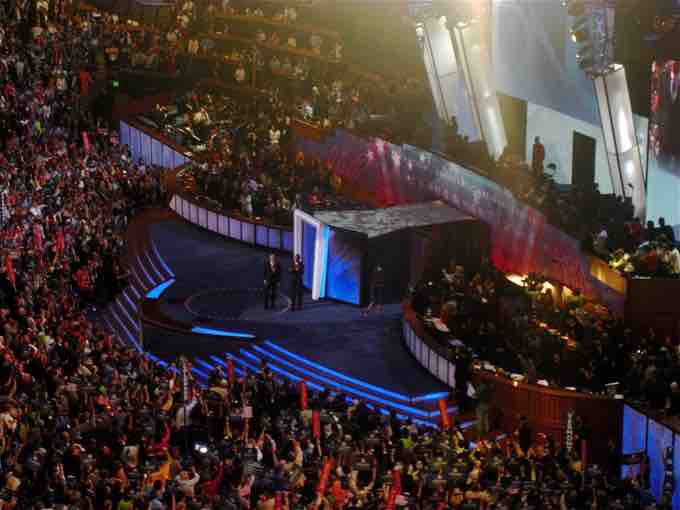Introduction
A national convention is a political convention held in the United States every four years by political parties fielding candidates in the upcoming presidential election. National party conventions are designed to officially nominate the party's candidate and develop a statement of purpose and principles called the party platform. Informally, political parties use the conventions to build support for their candidates.
Major political parties in the early 1830s were the first to use the political convention. These were often heated affairs, with delegates from each state playing a major role in determining the party's national nominee . The term "dark horse candidate" was coined at the 1844 Democratic National Convention when little-known Tennessee politician James K. Polk emerged as the candidate after the leading candidates failed to secure the necessary two-thirds majority vote.

Democratic National Convention (1876)
An image from a newspaper article about the 1876 Democratic National Convention in St. Louis, MO.
There is no such suspense at modern conventions. Due to primaries and increased access to national news, each party essentially knows who its candidate will be before the convention. Instead, modern conventions serve to rally support for the candidate . Conventions today are largely ceremonial events with little influence on the presidential campaign beyond how the convention is received in the press.

Democratic Party, 2008
An image of future President Barack Obama and Vice-President Joe Biden after they were officially nominated for the Democratic ticket at the 2008 Democratic National Convention.
Logistics
From the point of view of the parties, the convention cycle begins with the Call to Convention. Usually issued about 18 months in advance, the Call is an invitation from the national party to the state and territory parties to convene to select a presidential nominee. It also sets out the number of delegates to be awarded to each, as well as the rules for the nomination process. One reason for the late conventions has to do with campaign finance laws, which allow the candidates to spend an unlimited amount of money before the convention, but forbid fundraising after the convention, in order for the parties to receive federal campaign funds.
Each party sets its own rules for the participation and format of the convention. Broadly speaking, each U.S. state and territory party is apportioned a select number of voting representatives, individually known as delegates and collectively as the delegation. Each party uses its own formula for determining the size of each delegation, factoring in such considerations as population, proportion of that state's Congressional representatives or state government officials who are members of the party, and the state's voting patterns in previous presidential elections. The selection of individual delegates and their alternates, too, is governed by the bylaws of each state party, or in some cases by state law. The 2004 Democratic National Convention counted 4,353 delegates and 611 alternates.
The convention is typically held in a major city selected by the national party organization 18–24 months before the election is to be held. As the two major conventions have grown into large, publicized affairs with significant economic impact, cities today compete vigorously to be awarded host responsibilities, citing their meeting venues, lodging facilities, and entertainment as well as offering economic incentives.
Proceedings
Each convention produces a statement of principles known as its platform, containing goals and proposals known as planks. Relatively little of a party platform is even proposed as public policy. Much of the language is generic, while other sections are narrowly written to appeal to factions or interest groups within the party. Unlike electoral manifestos in many European countries, the platform is not binding on either the party or the candidate. Because it is ideological rather than pragmatic, however, the platform is sometimes itself politicized. For example, defenders of abortion lobbied heavily to remove the Human Life Amendment plank from the 1996 Republican National Convention platform, a move fiercely resisted by conservatives despite the fact that no such amendment had ever come up for debate. Given the same routines and repetition of proceedings, presidential nominating conventions have become predictable for observers of the political process.
Minor figures in the party are given the opportunity to address the floor of the convention during the daytime, when only the small audiences of C-SPAN and other cable television outlets are watching. The evening's speeches - designed for broadcast to a large national audience—are reserved for major speeches by notable, respected public figures; the speakers at the 2004 Democratic convention included Ted Kennedy, a forty-year veteran of the United States Senate, and Jimmy Carter, a former Democratic President, while at the Republican convention speakers included Governor Arnold Schwarzenegger of California and Governor George Pataki of New York, two of the largest states in the nation.